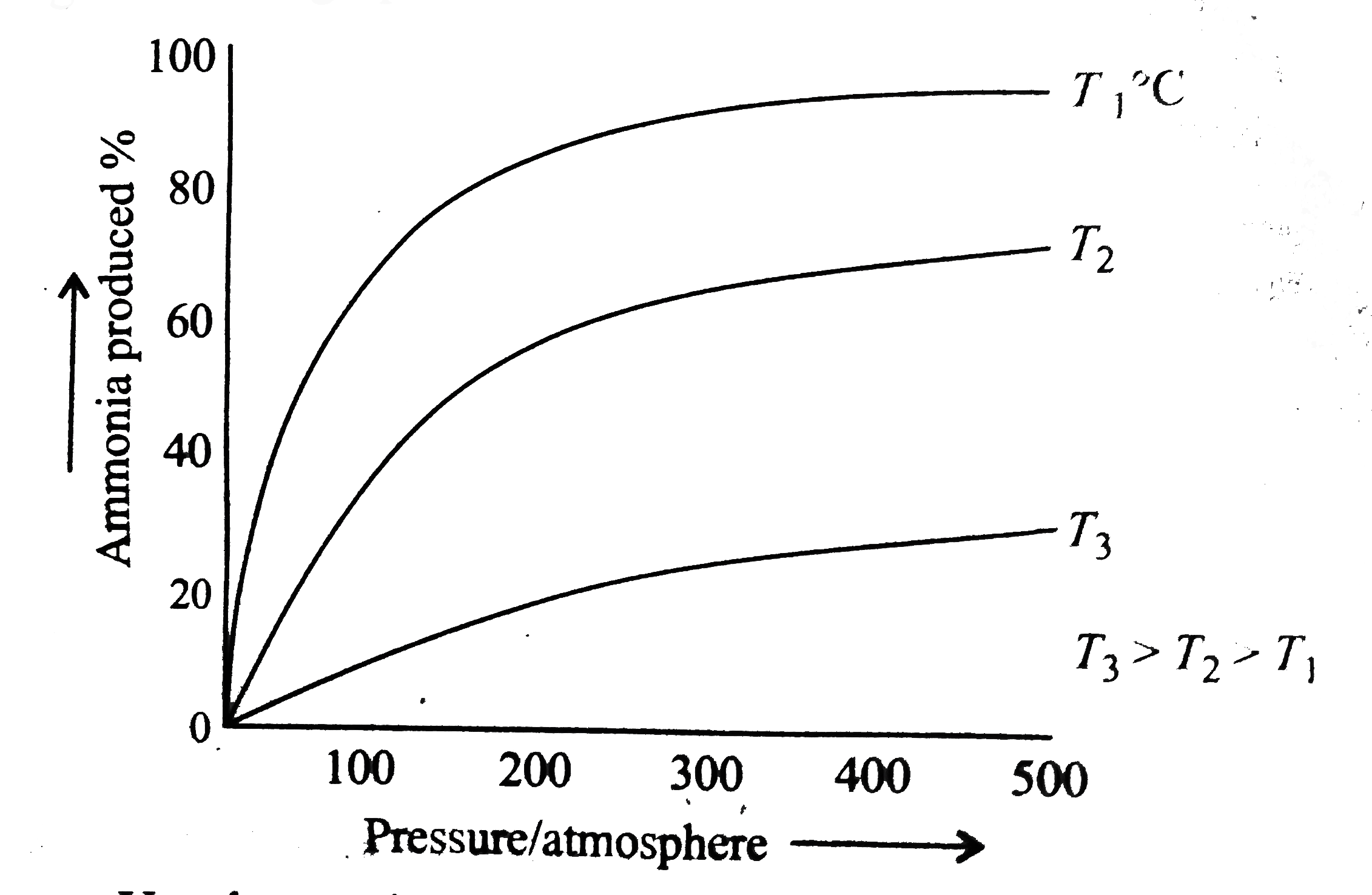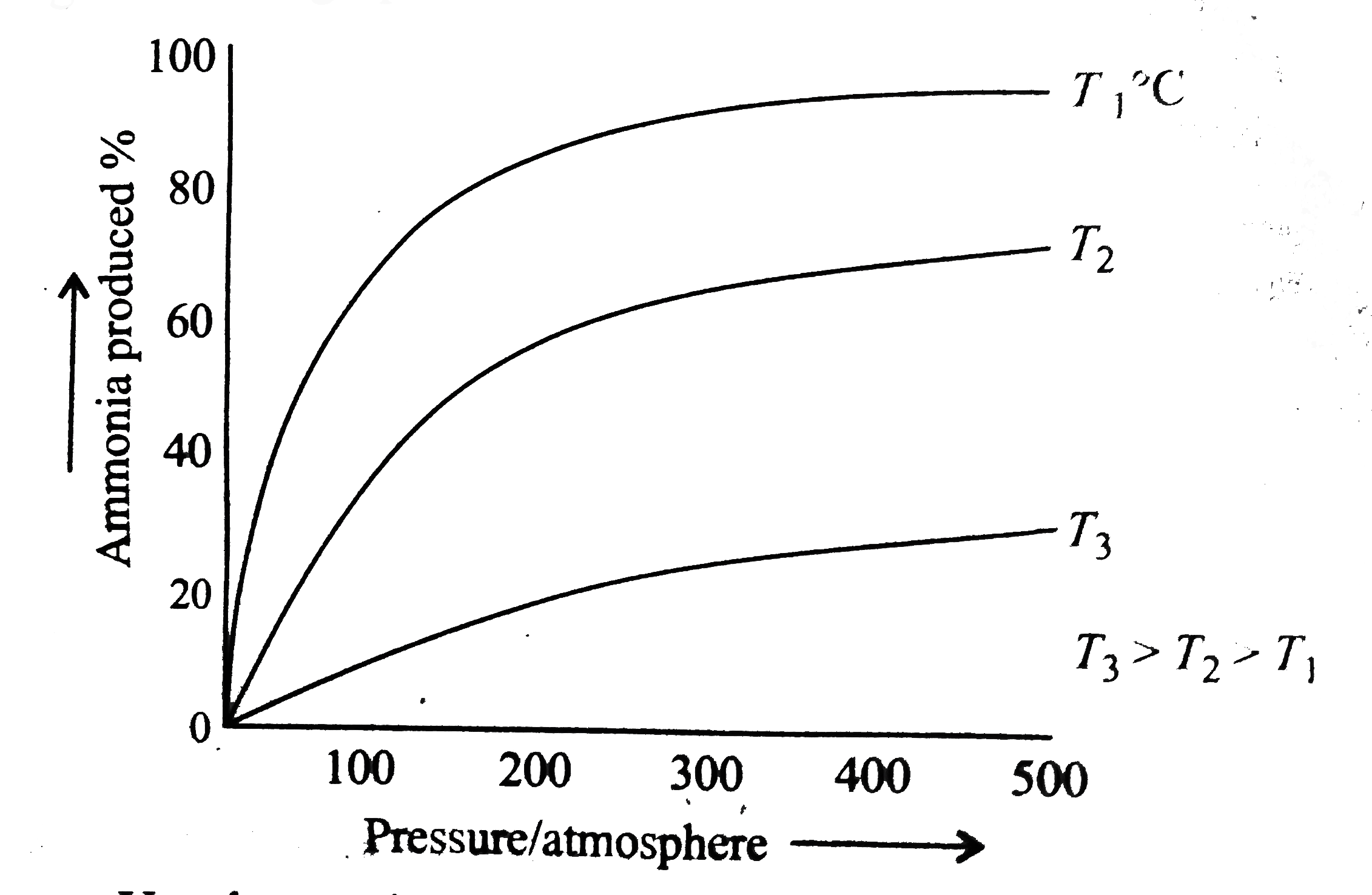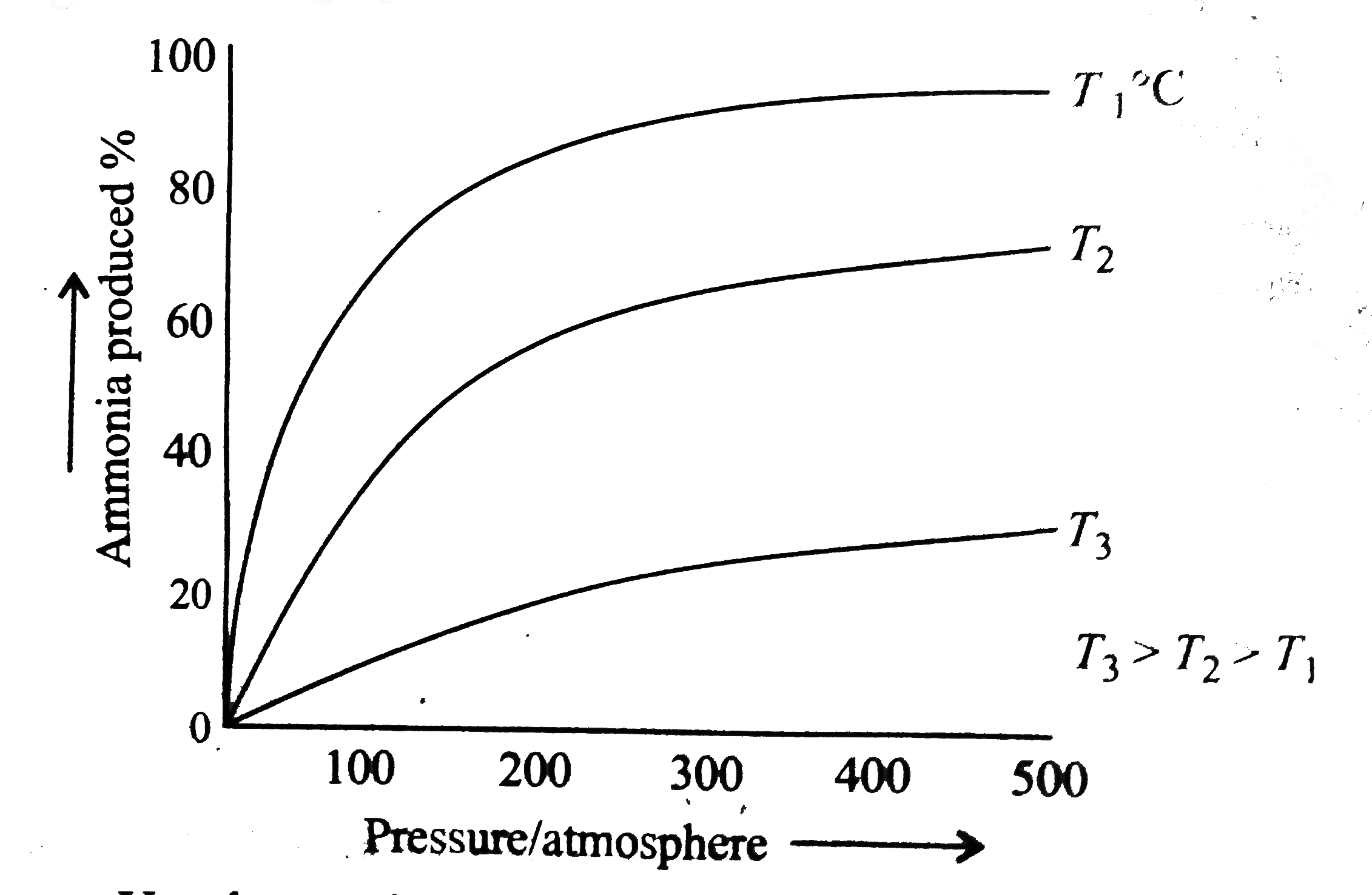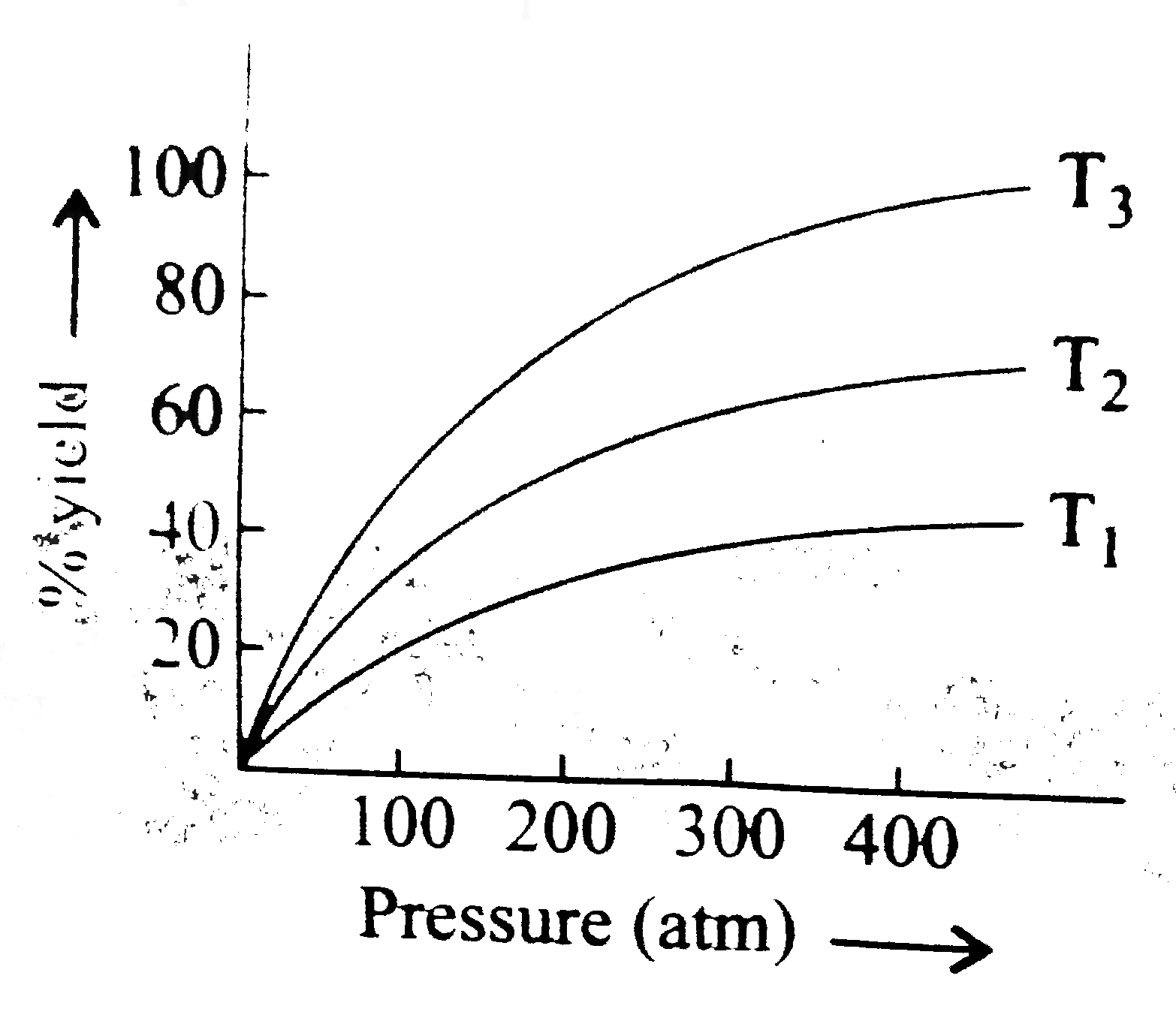Yield of Ammonia will be more in Haber's process under _____ conditions (L = Low, H = high T = Temp, p = Pressure )
LT , LP
LT , HP
HT, HP
HT, LP
The correct Answer is:B
To determine the conditions under which the yield of ammonia will be more in the Haber process, we need to analyze the reaction and its characteristics.
1. Understand the Haber Process: The Haber process synthesizes ammonia (NH₃) from nitrogen (N₂) and hydrogen (H₂) gases. The balanced chemical equation for the reaction is:
N2(g)+3H2(g)⇌2NH3(g)
2. Identify the Nature of the Reaction: This reaction is exothermic, meaning it releases heat. The enthalpy change (ΔH) for the reaction is negative (approximately -92 kJ/mol).
3. Analyze the Effect of Temperature:
- According to Le Chatelier's principle, if the temperature is decreased, the equilibrium will shift towards the exothermic direction to produce more heat.
- Therefore, lower temperatures favor the formation of ammonia.
4. Analyze the Effect of Pressure:
- The reaction involves a decrease in the number of moles of gas (from 4 moles of reactants to 2 moles of product).
- Increasing the pressure will shift the equilibrium towards the side with fewer moles of gas, which is the product side (ammonia).
- Thus, higher pressures favor the formation of ammonia.
5. Conclusion:
- To maximize the yield of ammonia in the Haber process, the conditions should be low temperature and high pressure.
- Therefore, the answer to the question is: Yield of Ammonia will be more in Haber's process under Low Temperature and High Pressure conditions (L, H).
Final Answer:
The yield of ammonia will be more in Haber's process under Low Temperature and High Pressure (L, H) conditions.
N2(g)+3H2(g)⇌2NH3(g)
- According to Le Chatelier's principle, if the temperature is decreased, the equilibrium will shift towards the exothermic direction to produce more heat.
- Therefore, lower temperatures favor the formation of ammonia.
- The reaction involves a decrease in the number of moles of gas (from 4 moles of reactants to 2 moles of product).
- Increasing the pressure will shift the equilibrium towards the side with fewer moles of gas, which is the product side (ammonia).
- Thus, higher pressures favor the formation of ammonia.
- To maximize the yield of ammonia in the Haber process, the conditions should be low temperature and high pressure.
- Therefore, the answer to the question is: Yield of Ammonia will be more in Haber's process under Low Temperature and High Pressure conditions (L, H).
The yield of ammonia will be more in Haber's process under Low Temperature and High Pressure (L, H) conditions.
Similar Questions
What is molar volume of an ideal gas under N.T.P. conditions ?
View SolutionThe persentage of ammonia produced from nitrogen and hydrogen under conditions of temperature and pressure is given in the graph

Use the graph answering the following questions:
What conditions of pressure produce the highest percentage of ammonia?
View SolutionThe persentage of ammonia produced from nitrogen and hydrogen under conditions of temperature and pressure is given in the graph

Use the graph answering the following questions:
What happens to the percentage of ammonia produced when the pressure is increased?
View SolutionThe persentage of ammonia produced from nitrogen and hydrogen under conditions of temperature and pressure is given in the graph

Use the graph answering the following questions:
What happens to the percentage of ammonia produced when the temperature is increased
View SolutionThe formation of ammonia by Haber's process is favoured by ………. pressure.
View SolutionChlorine combines with excess of ammonia to form ammonium chloride and nitrogen. Calculate the volume of ammonia required to completely react with 42 litres of chlorine. Under similar conditions of temperature and pressure.
View SolutionN2(g)+3H2(g)⇔2NH3(g),ΔHɵ=−22.4kJ
The pressure inside the chamber is 100 atm and temperature at 300K
The preparation of ammonia by Haber's process is an exothermic reaction. If the preparation follows the following temperature-pressure relationship for its % yield. Then for temperature T1,T2 and T3 the correct option is:

View SolutionIn the industrial preparation of ammonia by Haber process from nitrogen and hydrogen, the reaction is carried in the temperature range of 450∘C to 500∘C and in a pressure range of 200 atm to 300 atm. Now answer the following question.
The reaction is not carried at very high pressure. Give one reason.
View SolutionDihydrogen gas used in Haber's process is produced by reacting methane from natural gas with high temperature steam. The first stage of the two 2 stage reaction involves the formation of CO and H2. In second stage, CO formed in first stage is reacted with more steam in water gas shift reaction,
CO(g)+H2O(g)⇔CO2(g)+H2(g)
If a reaction vessel at 400∘C is charged with an equimolar mixture of CO and steam such that pCO=pH2O=4.0 bar, what will be the partial pressure of H2 at equilibrium? Kp=0.1 at 400∘C.
View SolutionWhat volume of nitrogen dioxide would be formed when 100cm3 of NO read with 50cm3 of O2 under same conditions of temp. and pressure.
2NO+O2→2NO2
View Solution
